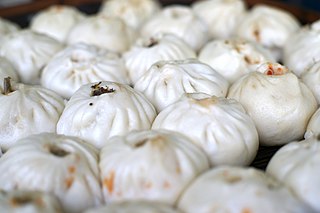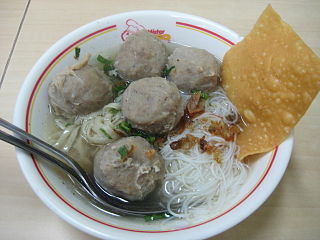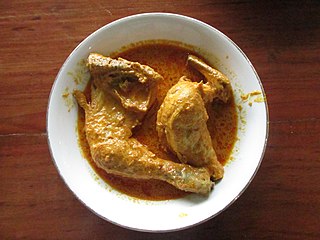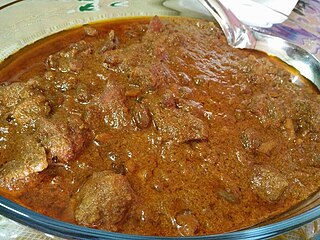
Malaysian cuisine consists of cooking traditions and practices found in Malaysia, and reflects the multi-ethnic makeup of its population. The vast majority of Malaysia's population can roughly be divided among three major ethnic groups: Malays, Chinese and Indians. The remainder consists of the indigenous peoples of Sabah and Sarawak in East Malaysia, the Orang Asli of Peninsular Malaysia, the Peranakan and Eurasian creole communities, as well as a significant number of foreign workers and expatriates.

Nasi lemak is a dish originating in Malay cuisine that consists of fragrant rice cooked in coconut milk and pandan leaf. It is commonly found in Malaysia, where it is considered as the national dish. It is also a native dish in neighbouring areas with significant ethnic Malay populations such as Singapore and Southern Thailand. In Indonesia it can be found in several parts of Sumatra, especially the Malay regions of Riau, Riau Islands and Medan. It is considered an essential dish for a typical Malay-style breakfast. Nasi lemak is featured as a national dish in most of the country's tourism brochures and promotional materials.

Malay cuisine is the traditional food of the ethnic Malays of Southeast Asia, residing in modern-day Malaysia, Indonesia, Singapore, Brunei, Southern Thailand and the Philippines as well as Cocos Islands, Christmas Island, Sri Lanka and South Africa.

Rendang is a Minangkabau dish. It is a rich meat dish that has been slow cooked and braised in a coconut milk and seasoned with a herb and spice mixture over a period of several hours until the liquids evaporate, and the meat turns dark brown and tender, becoming caramelized and infused with rich flavours.

Baozi, or simply bao, is a type of yeast-leavened filled bun in various Chinese cuisines. There are many variations in fillings and preparations, though the buns are most often steamed. They are a variation of mantou from Northern China.

Motabbaq is a stuffed pancake or pan-fried bread which is commonly found in the Arabian Peninsula, South Asia and Southeast Asia, notably in Saudi Arabia, Yemen, Indonesia, Malaysia, Singapore, Brunei, Southern Thailand and Bangladesh. Depending on the location, the name and ingredients can significantly vary. The name mutabbaq in Arabic means "folded". It is a popular street food in Yemen, Indonesia, Malaysia, Thailand and Singapore.

Massaman curry is a rich, flavourful, and mildly spicy Thai curry. It is a fusion dish, combining ingredients from three sources: Persia, the Indian Subcontinent, and the Malay Archipelago with ingredients more commonly used in native Thai cuisine to make massaman curry paste. The substance of the dish is usually based on chicken or other meat, potatoes, onions, and peanuts. The richness comes from the coconut milk and cream used as a base, as for many Thai curries.

A curry puff is a snack of Southeast Asian origin. It is a small pie consisting of curry with chicken and potatoes in a deep-fried or baked pastry shell. The consistency of the curry is quite thick to prevent it from oozing out of the snack. Pap or puff reflects the Fujian Chinese dialect 泡 ('pop'), which means 'bubble, blister, puffed'. It is a truly Southeast Asian snack as it has Indian, Chinese or Malay elements.

Bakso or baso is an Indonesian meatball, or a meat paste made from beef surimi. Its texture is similar to the Chinese beef ball, fish ball, or pork ball. The word bakso may refer to a single meatball or the complete dish of meatball soup. Mie bakso refers to bakso served with yellow noodles and rice vermicelli, while bakso kuah refers to bakso soup served without noodles.

Serundeng refers to a spicy grated coconut side dish or condiment, to accompany rice in Indonesian language. Serundeng may taste sweet, or hot and spicy according to recipe variants.

Nasi tumpang is a rice dish originating in Kelantan, Malaysia. Nasi tumpang is rice with different layer of dishes wrapped in a cone shape with banana leaf packed. Traditionally, it was staple food for travelers or farmers in Kelantan to bring to work. It is packed tightly consisting an omelette, beef or fish floss, and shrimp or fish local curry, sweet sambal gravy and cucumbers.

Kelantanese Malays are a sub-ethnic group of Malays native to the state of Kelantan, Malaysia as well as in Northern Terengganu. The Kelantanese Malays are closely related to Thai Malays and Terengganuan Malays in neighbouring Terengganu, these two Malay sub-ethnic groups shared historical, cultural and linguistic as well as kinship ties with the Kelantanese Malays. Kelantanese Malays form 94% of Kelantan's population, which makes them the largest ethnic group in Kelantan and around 150,000 in Besut, Terengganu.

Roti canai or roti prata, also known as roti chanai, roti chennai and roti cane, is an Indian flatbread dish found in several countries in Southeast Asia, especially in Brunei, Indonesia, Malaysia, Singapore and Thailand. It is usually served with dal or other types of curry, but can also be cooked in a range of sweet or savoury variations made with a variety of ingredients such as meat, eggs, or cheese.

Gulai is a class of spicy and rich stew commonly found in Indonesia, Malaysia and Singapore. The main ingredients of this dish are usually poultry, goat meat, beef, mutton, various kinds of offal, fish and seafood, as well as vegetables such as cassava leaves, unripe jackfruit and banana stem.

Akok is one of the famous traditional foods in the east coast of Peninsular Malaysia, notably the states of Kelantan and Terengganu. The kuih is can be consumed as a snack or as a dessert. It is made with flour, sugar, eggs, and coconut milk.

Kuzi ayam or ayam masak kuzi is a traditional food in Kelantan, Malaysia.

Nasi minyak is an Indonesian dish from Palembang cuisine of cooked rice with minyak samin (ghee) and spices. This rice dish is commonly associated with Palembang city, the capital of South Sumatra province. However, it is also common in neighboring Jambi as far north to Medan in North Sumatra. Nasi minyak looks and tastes similar to nasi kebuli, this is because both rice dishes are influenced by Indian and Middle Eastern cuisines, as evidence in the use of ghee and certain spices. Bumbu spice mixture being used including cardamom, anise, clove, caraway, cinnamon, onion, garlic and curry powder.

Acehnese cuisine is the cuisine of the Acehnese people of Aceh in Sumatra, Indonesia. This cuisine is popular and widely known in Indonesia. Arab, Persian, and Indian traders influenced food in Aceh although flavours have substantially changed their original forms. The spices combined in Acehnese cuisine are commonly found in Indian and Arab cuisine, such as ginger, pepper, coriander, cumin, cloves, cinnamon, cardamom, and fennel. A variety of Acehnese food is cooked with curry or coconut milk, which is generally combined with meat such as buffalo, beef, goat meat, lamb, mutton, fish, or chicken.

Indian Indonesian cuisine is characterized by the mixture of Indian cuisine with local Indonesian-style. This cuisine consists of adaptations of authentic dishes from India, as well as original creations inspired by the diverse food culture of Indonesia. Indian influence can be observed in Indonesia as early as the 4th century. Following the spread of Islam to Indonesia and trading, Muslim Indian as well as Arab influences made their way into Indonesian cuisine. Examples include Indian biryani, murtabak, curry and paratha that influenced Acehnese, Minangkabau, Malay, Palembangese, Betawi and Javanese cuisine.



















